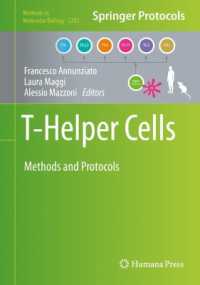Full Description
Motor Control Methods and Clinical Applications provides a detailed review of the use of non-invasive brain stimulation to study motor control. Split into two distinct parts, the volume will cover the latest research in motor control and real examples of these methods in a clinical setting. The first part will cover advanced methods including transcranial magnetic, electrical and ultrasound stimulation, long latency and spinal reflexes, multichannel EMG and EEG-EMG analyses can be used to examine and modulate the motor system. The second part of the book addresses the clinical applications of these methods.
Contents
Part 1 Methods
1. Transcranial magnetic stimulation: positive effects (includes single and paired pulse methods, and triple-stimulation-technique)
2. Transcranial magnetic stimulation: negative motor effects (contralateral and ipsilateral silent periods)
3. Modulation of TMS motor-evoked potentials by muscle contraction, motor imagery, action observation, action preparation
4. Effect of non-invasive brain stimulation on voluntary movements (such as effects on RT, ballistic movement, kinematic effects, with TMS, including TES if appropriate)
5. Induction of motor system plasticity using transcranial magnetic stimulation (e.g., regular rTMS, TBS, PAS, QPS, sTMS etc)
6. Induction of motor system plasticity using transcranial electrical stimulation (tDCS, tACS, random noise stimulation
7. Induction of motor system plasticity using transcranial ultrasound stimulation
8. Induction of motor system plasticity using temporal interference stimulation
9. Contributions of spinal epidural recordings to mechanisms of TMS and TES
10. Corticomuscular or EEG-EMG coherence, and intermuscular or EMG-EMG coherence
11. TMS-EEG - relation to motor physiology
12. ERD/ERS, BP (EEG/MEG), multichannel surface EMG, EMG-EEG backaveraging
13. Brain computer interfaces in the motor system: the technologies
14. Long-latency reflexes and cutaneous reflexes
15. Brainstem reflexes and startle reaction
16. Spinal reflexes (H-reflex, reciprocal inhibition)
Part 2: Clinical Applications:
17. Utility of TMS in the diagnosis of neurological disorders
18. Electrophysiological studies in the diagnosis of movement disorders (multiple channel surface EMG, EMG-EEG backaveraging, for tremor, muscle jerks/myoclonus)
19. Clinical use of TMS-EEG in the motor system
20. Clinical applications of ultrasound neuromodulation of the motor system
21. Clinical application of rTMS/tDCS as treatment in motor disorders (e.g. ALS, PD)
22. Clinical applications of Brain computer interfaces in the motor system







